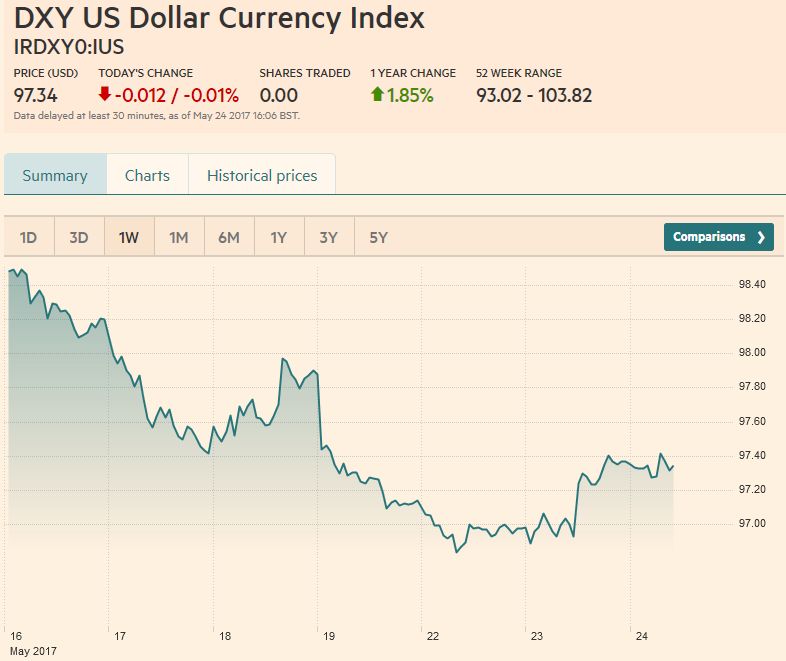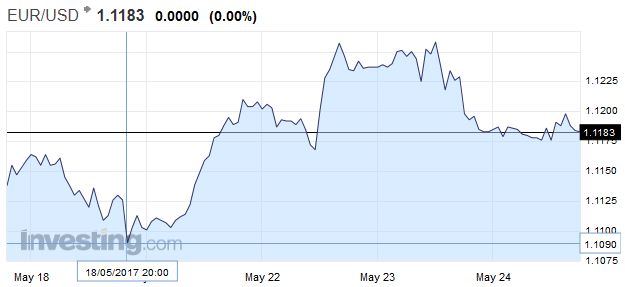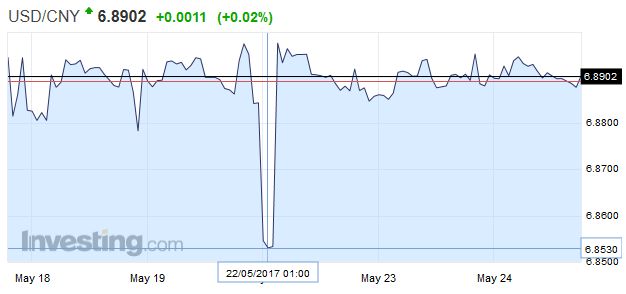Summary:
The dollar’s downside momentum faded today, but it has not shown that it has legs.
Watch 96.45 in the DXY and $1.3055 in sterling.
The US 2-year note yield is low, given expectations for overnight money.
The US premium needs to widen.
The US dollar’s downside momentum faded today. While one should not read much into it, it could be an early sign that the market has discounted the recent news stream, which includes the fear that the political turmoil in the Washington will adversely impact the President’s economic program, and the continued above trend growth in the eurozone.
The Fed funds futures continue to discount a strong change of a June Fed hike. Bloomberg puts the odds at 95% of a hike, while the CME’s model says it is about 83% discounted. Our calculation puts it at 81%. A June hike would put the Fed funds target range at 1.00%-1.25%.
Although the two-year note is trading a few basis points through the top of the presumed new range, the odds that the Fed funds target range will be 1.25%-1.50% by the end of the year is also rising slowly. Bloomberg sees a 45% chance, up from about 28% a month ago. The CME sees the odds at 39% compared with about 30% a month ago.
European growth remains above trend and the flash May PMIs today suggest another strong quarter. However, price pressures remain elusive. Prices in the PMI fell for the first time in 15 months. To suggest the ECB could hike rates if it weren’t for the low inflation , is like asking, “Besides that Mrs Lincoln, how was the play?”
For the ECB with a single mandate, inflation is the story. Draghi has confirmed this many times. The market may be getting ahead of itself, not only the impeachment story in the US, but on how aggressive the ECB will be next month. It is not going to change what it is doing, such as taper. It is going to tell the market what it already knows. Eurozone policy rates have bottomed (deposit rate at minus 40 bp) and the risks to growth are balanced.
There four numbers to watch in the foreign exchange market that will be important for shaping the dollar’s near-term outlook.
| First, 96.45 in the Dollar Index is the 61.8% retracement of the rally from last May when it slipped below 92.00. A bit below there is the low from the November election near 95.90. A break would bring the minimum measuring objective of the possible head and shoulders top pattern (carved out between November 2016 and March 2017, which we were skeptical of), near 94.80 into view. |
US Dollar Currency Index, May 24(see more posts on U.S. Dollar Index, ) |
| Second, $1.3055 in sterling is the 38.2% retracement of sterling drops since the referendum last June. A break of it would target the 50% retracement near $1.3430.
Third, in order for the dollar to find better traction US rates did need to rise. With a reasonable risk that Fed funds finish the year in a 1.25%-1.50% range, and additional hikes next year, the two-year note yield at 1.30% seems unreasonably low. The yield peaked near 1.40% on the day the Fed hiked in mid-March. Fourth, the US two-year premium over Germany has been trending lower since reaching almost 2.23% on March 9. Ironically, the US premium is now lower than it was when the Fed hiked in December 2016 and March 2017. It is now at the lower end of its range since the Fed hiked. The premium is near 1.94%. It has not been below 1.92% since the end of January. Over the past month, as the need for a safe haven in Europe diminished, Germany’s two-year yield has risen 15 bp, while French, Italian Spanish, Portuguese yields have fallen. At the same time, the US yield has risen 12 bp. If the dollar is going to get better traction against the euro, it will need a larger interest rate premium. Often, we mind the direction of change is more important than the absolute level of the premium, but a larger premium may be needed to compensate for other risks, such a political risks. |
EUR/USD - Euro US Dollar, May 24(see more posts on EUR/USD, ) |
| Our work finds that recently the US-German 10-year premium is more correlated with the euro (percentage change, 60-day rolling basis) than the two-year spread. The two-year correlation is 0.55 which, except for the January-March period has rarely been greater. The 10-year correlation is at 0.67. This is the most since at least 2000.
The dollar-yen exchange rate remains highly correlated with the 10-year yield. That correlation is near 0.72 now. It had reached 0.78 in early March, was one of the strongest correlations since 2000. The two-year interest rate differential is also important. The correlation now is a little more than 0.62. It had fallen to almost 0.45 in April after peaking near 0.67 in January and February. Last year, the correlation did not rise above 0.60 in the first half and peaked in August near 0.67. |
USD/CNY - US Dollar Chinese Yuan, May 24(see more posts on USD/CNY, ) |
Full story here Are you the author? Previous post See more for Next post
Tags: #GBP,#USD,$EUR,$JPY,EUR/USD,Interest rates,newslettersent,U.S. Dollar Index,USD-CNY







































